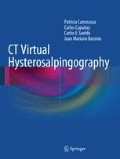Abstract
The advantages of computed tomography (CT) are immense and have revolutionized the practice of medicine. Since its birth, the applications of CT have extended to different regions and areas of the body, allowing vast advances in the non invasive diagnosis of numerous diseases. Currently, most of the radiation applied for diagnostic purposes arises from the use of CT, nuclear medicine and fluoroscopy. Furthermore, in the last decade with the oncoming of multislice CT (MSCT), there occurred a sustained increase in the utilization of this modality worldwide, with the consequent rise of the radiation dose in the population. This fact has caught the attention of health authorities, the medical community in general and, specially, of radiologists, becoming a topic of high interest and importance around the globe.
Access this chapter
Tax calculation will be finalised at checkout
Purchases are for personal use only
References
Wiest PW, Locken JA, Heintz PH, et al. CT scanning: a major source of radiation exposure. Semin Ultrasound CT MR. 2002;23:402–10.
Applegate KE, Amis Jr ES, Schauer DA, et al. Radiation exposure from medical imaging procedures. N Engl J Med. 2009;361:2289–90.
Brenner DJ, Hall EJ. Computed tomography: an increasing source of radiation exposure. N Engl J Med. 2007;357:2277–84.
National Council on Radiation Protection and Measurements, NCRP Report No. 160, Marzo de 2009.
De “White Paper: Initiative to reduce unnecessary radiation exposure from medical imaging”. En sitio web: http://www.fda.gov.
Preston DL, Ron E, Tokuoka S, et al. Solid cancer incidence in atomic bomb survivors: 1958–1998. Radiat Res. 2007;168:1–64.
Shimizu Y, Kodama K, Nishi N, et al. Radiation exposure and circulatory disease risk: Hiroshima and Nagasaki atomic bomb survivor data, 1950–2003. BMJ. 2010;340:b5349.
Smith-Bindman R, Lipson J, Marcus R, et al. Radiation dose associated with common computed tomography examinations and the associated lifetime attributable risk of cancer. Arch Intern Med. 2009;169:2078–86.
Brenner DJ, Doll R, Goodhead DT, et al. Cancer risks attributable to low doses of ionizing radiation: assessing what we really know. Proc Natl Acad Sci U S A. 2003;100:13761–6.
McCollough CH, Bruesewitz MR, Kofler Jr JM. CT dose reduction and dose management tools: overview of available options. Radiographics. 2006;26:503–12.
Lee CH, Goo JM, Ye HJ, et al. Radiation dose modulation techniques in the multidetector CT era: from basics to practice1. Radiographics. 2008;28:1451–9.
Fernández JM, Vañó E, Guibelalde E. Patient doses in hysterosalpingography. Br J Radiol. 1996;69(824):751–4.
Perisinakis K, Damilakis J, Grammatikakis J, et al. Radiogenic risks from hysterosalpingography. Eur Radiol. 2003;13(7):1522–8.
Fife IA, Wilson DJ, Lewis CA. Entrance surface and ovarian doses in hysterosalpingography. Br J Radiol. 1994;67(801):860–3.
Papaioannou S, Afnan M, Coomarasamy A, et al. Long term safety of fluoroscopically guided selective salpingography and tubal catheterization. Hum Reprod. 2002;17:370–2.
Gregan AC, Peach D, McHugo JM. Patient dosimetry in hysterosalpingography: a comparative study. Br J Radiol. 1998;71(850):1058–61.
Karande VC, Levrant SG, Pratt DE, et al. What is the radiation exposure to patients during a gynaecoradiologic procedure? Fertil Steril. 1997;67:401–3.
Carrascosa P, Capuñay C, Baronio M, et al. 64-Row multidetector CT virtual hysterosalpingography. Abdom Imaging. 2009;34(1):121–33.
Carrascosa PM, Capuñay C, Vallejos J, et al. Virtual hysterosalpingography: a new multidetector CT technique for evaluating the female reproductive system. Radiographics. 2010;30(3):661–2; discussion 663.
McCollough CH, Zink FE. Performance evaluation of a multi-slice CT system. Med Phys. 1999;26:2223–30.
Kalra MK, Maher MM, Toth TL, et al. Strategies for CT radiation dose optimization. Radiology. 2004;230:619–28.
Wilting JE, Zwartkruis A, van Leeuwen MS, et al. A rational approach to dose reduction in CT: individualized scan protocols. Eur Radiol. 2001;11:2627–32.
Kulama E. Scanning protocols for multislice CT scanners. Br J Radiol. 2004;77:S2–9.
Mori S, Endo M, Obata T, et al. Properties of the prototype 256-row (cone beam) CT scanner. Eur Radiol. 2006;16:2100–8.
Kalra MK, Maher MM, Toth TL, et al. Techniques and applications of automatic tube current modulation for CT. Radiology. 2004;233:649–57.
Kalra MK, Maher MM, Toth TL, et al. Comparison of z-axis automatic tube current modulation technique with fixed tube current CT scanning of abdomen and pelvis. Radiology. 2004;232:347–53.
La Rivière PJ. Penalized-likelihood sinogram smoothing for low-dose CT. Med Phys. 2005;32:1676–83.
Author information
Authors and Affiliations
Rights and permissions
Copyright information
© 2014 Springer International Publishing Switzerland
About this chapter
Cite this chapter
Carrascosa, P., Capuñay, C., Sueldo, C.E., Baronio, J.M. (2014). Radiation Dose. In: CT Virtual Hysterosalpingography. Springer, Cham. https://doi.org/10.1007/978-3-319-07560-0_14
Download citation
DOI: https://doi.org/10.1007/978-3-319-07560-0_14
Published:
Publisher Name: Springer, Cham
Print ISBN: 978-3-319-07559-4
Online ISBN: 978-3-319-07560-0
eBook Packages: MedicineMedicine (R0)

